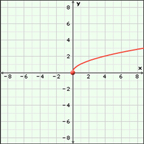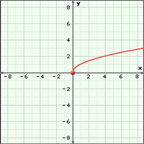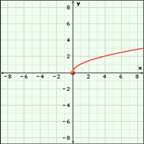In Try This 2 you graphed the simplest radical function possible: ![]() Did you notice the distinct shape that you graphed? You may remember this shape from Try This 1 in Discover. You have now seen two radical functions with this distinct shape. This shape is sometimes describes as one-half of a parabola opening to the right. The domain of the function is {x|x ≥ 0, y ∈ R} because you cannot take the square root of a negative number. The range of the function is {y|y ≥ 0, y ∈ R}.
Did you notice the distinct shape that you graphed? You may remember this shape from Try This 1 in Discover. You have now seen two radical functions with this distinct shape. This shape is sometimes describes as one-half of a parabola opening to the right. The domain of the function is {x|x ≥ 0, y ∈ R} because you cannot take the square root of a negative number. The range of the function is {y|y ≥ 0, y ∈ R}.
Radical functions can be much more complex than the function you graphed in Try This 2. The general form of a radical function can be written as ![]() Do you see the similarities in this form to the general form for functions used in Module 1?
Do you see the similarities in this form to the general form for functions used in Module 1?
In Try This 3 you will investigate how the graph of radical functions changes in response to changes in the parameters a, h, and k of the general form of the function.
Try This 3
Open “Functions Involving Square Roots.”
Select the “Show domain” and “Show range” boxes in the gizmo.
This gizmo begins with a graph of ![]() Check that your graph, the domain, and the range from Try This 2 match this graph.
Check that your graph, the domain, and the range from Try This 2 match this graph.
- Use the slider to change the value of a, and record your answers in a chart like the following.

a-value
Function
Domain
Range
Transformation of Graph and State the Stretch Factor
Sketch or Image
1 
{x|x ≥ 0, x ∈ R}
{y|y ≥ 0, y ∈ R}
none 
Screenshot reprinted with
permission of ExploreLearning.Positive value:
________
Negative value:
________
-
Set the a-value back to 1. Use the slider and change the value of h, and record your answers in a chart like the following.

h-value
Function
Domain
Range
Transformation of Graph and State the Value of the Translation
Sketch or Image
0 
{x|x ≥ 0, x ∈ R}
{y|y ≥ 0, y ∈ R}
none 
Screenshot reprinted with
permission of ExploreLearning.Positive value:
________Negative value:
________ - Set the h-value back to zero. Use the slider, change the value of k, and record your answers in a chart like the following.
k-value
Function
Domain
Range
Transformation of Graph and State the Value of the Translation
Sketch or Image
0 
{x|x ≥ 0, x ∈ R}
{y|y ≥ 0, y ∈ R}
none 
Screenshot reprinted with
permission of ExploreLearning.Positive value:
________Negative value:
________
Open Multiple Transformations. Click on “Quadratic” to deselect it, and click on “Square root” to select this type of function.

- Change the a, b, h, and k sliders to explore what happens to the graph when these values are changed. In a chart like the following, summarize how the parameters a, b, h, and k transform the graph given in the general form

Parameter Value > 0 Value < 0 a b h k
![]() Save your responses in your course folder.
Save your responses in your course folder.
